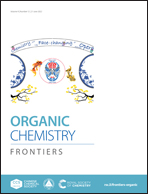Cutting edge of diphenyl phosphorazidate (DPPA) as a synthetic reagent – A fifty-year odyssey
Abstract
Recent advances of diphenyl phosphorazidate (DPPA) as a versatile synthetic reagent was described. It works as an azide anion equivalent, 1,3-dipole, electrophile, and nitrene. Thus it can be conveniently used for amide synthesis, ester synthesis, modified Curtius reaction, phosphorylation, C-acylation, azide synthesis, Pummerer rearrangement, cycloadditions, diazotization, triazoline formation, Staudinger reaction, amidine and guanidine synthesis, C–H phosphorazidation, nitrene insertion, decarbonylation, etc.

- This article is part of the themed collection: 2022 Organic Chemistry Frontiers Review-type Articles


 Please wait while we load your content...
Please wait while we load your content...